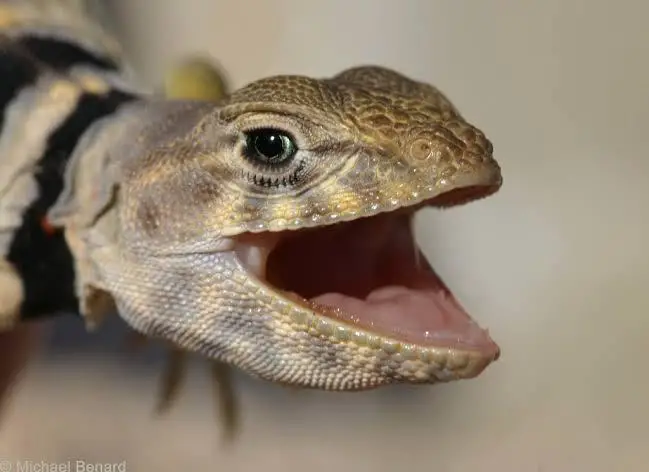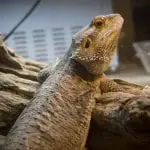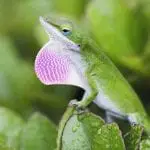Seeing your meal on its way to your table and being served right in front of you is definitely one of the best feelings in the world. And when a spoonful of your dinner hits your taste buds and fills your tummy at the end, the satisfaction sinks in. In the process of eating, the teeth play an important role in being able for our food to digest easily. The same of course goes for our furry and scaly friends. Unlike most teeth commonly seen among animals, lizards have a unique set of pearly whites that set them apart from other creatures.
Lizard Dentition
Dentition, defined as the condition and arrangement of teeth in a certain individual or species, is one of a kind in the land of lizards. The most popular types of teeth we know of are those seen in mammals, namely the incisors (these help you bite into your food), canines (these are the sharpest teeth for tearing your food apart, also known as the “dog teeth”), premolars (are used to cut and crush food and have a flat bite), and molars (usually the biggest teeth in mammals and work similarly to premolars).
For lizards, they have an entirely different case. Here are the facts about the dentition of lizards:
1. Lizards Have Helpful Teeth
You would probably wonder if lizards even need teeth since you would only see their tongue doing all the action out there, just a quick and long flick to capture their prey. So to make it all clear, lizards indeed do have teeth, and they need them just as much as we do.
2. Lizards Have One Type of Teeth
Lizards, in general, possess only one type of teeth except for a select few species which have a mixed dentition or more than one type when it comes to their set of teeth. The teeth found in lizards are designed to suit their needs and have serval functions that help them survive the wild.
Video Source: Youtube
3. Common Visible Teeth Feature
A commonly shared feature that is visible among most lizards is their sharp cone-like shaped teeth that also help in capturing their food and pushing it down to the digestive tract, which is the main purpose of their dentition. Meanwhile, other species have jagged or saw-like curved teeth that help keep a hold on their prey and for tearing it.
A few others have a sort of dip or hollow in the teeth that connect to sacks that release venom when they bite as a form of defense, accompanied by scratching with their claws and whipping an enemy with the use of their tail. They can even get quite naughty when searching for their own lizard lover, as males may bite females while mating. They put the “wild” in “wildlife,” huh?
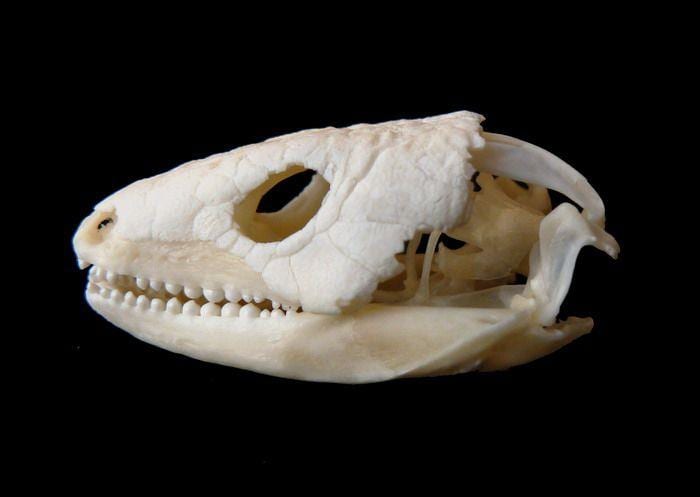
Lizard Dentition: Classified
As mentioned earlier, mammals have four types of teeth. For lizards, however, there are only two classifications: the Acrodont teeth and Pleurodont teeth. When referring to reptiles in general, there are three types, including the two aforementioned and Thecodont teeth, which are found in bigger reptiles like crocodiles. When Acrodont and Pleurodont teeth are both present in the mouth, this known as heterodont, and a uniform set of teeth is called a homodont.

Fused to Lose: Acrodont Teeth
Acrodont teeth are similar to bay teeth in human beings. While lizards are still young, these teeth can grow back when removed and become permanent as they start to mature (no need for a visit from the tooth fairy). However, these teeth can no longer be replaced when they reach their adult phase.
Acrodont teeth are known to be weak, and although they are fused to the tooth-bearing bone or jaw (often right at the top), they are not fixed on firmly and have short roots, causing them to fall out easily. These teeth are mainly characterized by their sharp points that effortlessly tear and chew their food. Their diet consists of a mix of vegetables and invertebrates, while larger lizards can eat small mammals.
Lizards that have acrodont teeth are often prone to infection from bacteria, a leading result being mouth rot. Lizards, with this kind of dentition, should be handled carefully, especially while being fed. Remember to always wash your hand before and after touching lizards to avoid spreading or catching infections. Agamids, uromascytes, chameleons, bearded dragons, and frilled dragons all have teeth that fall under the acrodont class.
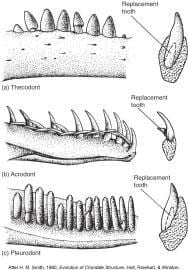
Powerfully packed Puncture: Pleurodont teeth
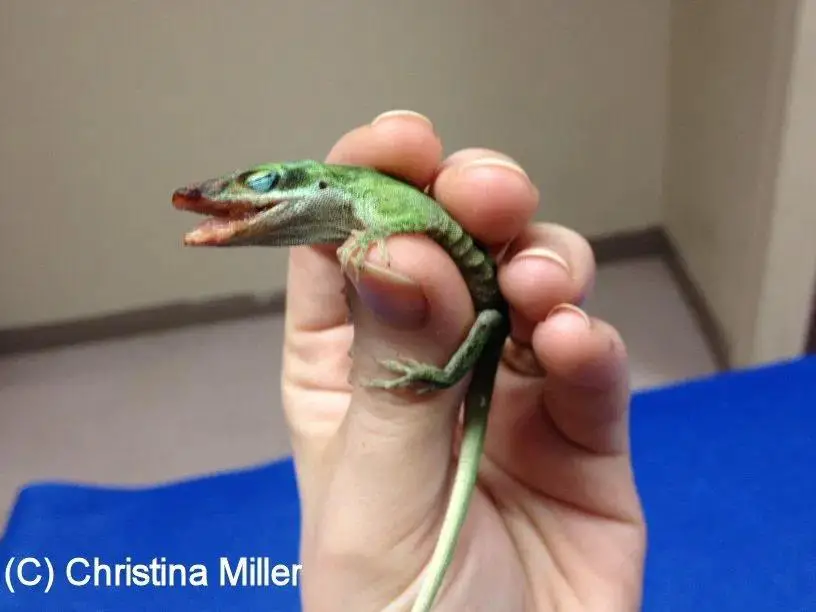
Unlike the acrodont class, pleurodont teeth are stronger and are firmly attached to the jaw of the lizard.
Here are the good-to-know facts about Pleurodont teeth:
- This type of teeth is suited for lizards with a “meatier” diet, which requires teeth as tough as nails to chomp on their food. The teeth are also replaced numerous times in a lizard’s life as they tend to dislodged as they capture their prey or while it attempts to free itself.
- Lizards that fall under the pleurodont teeth group may even swallow their own teeth while eating (now that’s what you call hardcore).
- When one tooth is lost, the entire set is usually replaced, not all at the same time, of course. This ensures that teeth will always be sharp as it can grow dull from their meals. These mean and lean lizards feed on mollusks, crustaceans, birds, and other small animals.
- The sharpness of their teeth depends on the type of species as this should reflect on the food they eat. An iguana, for example, has a diet that mainly consists of greens, so the teeth are intended for cutting up fruit and leaves, unlike a Komodo dragon that has a re-curve and conical shape to their teeth to keep food in the place. You can find pleurodont teeth in iguana subspecies, varanid monitors, and geckos.
Oral Care for Pet Reptiles
Reptiles, like lizards, also need oral or dental care like any other animals and human beings.
Your pet reptile is at risk of different health problems that come from its own mouth. For instance, the most common oral or dental health condition among reptiles is mouth rot.
It is also called in the medical world as Ulcerative Stomatitis, which is an infection of the gums and mouth of a lizard caused by food stuck and small cuts in the teeth. If it is left untreated, there will be a widespread infection that could kill your pet reptile. Lizards are vulnerable to this oral disease. Fortunately, mouth rot is easy to monitor and treat nowadays.
What to Check
It’s important to check the mouth of your reptile mouth for any huge food particle that is stuck between its gums and teeth, and for any cuts found in the oral tissue. If ever you find these markings, check for more signs and symptoms of oral or mouth rot including the following:
- Lack of appetite or shows no interest in food
- Decreased intake of water
- Yellow plaques found in soft oral tissue
- Thickening of saliva
- Yellow cheesy pus surrounding the mouth
- Swelling of gum tissue
- Swelling of the face and the head in advanced cases
It’s crucial to contact the vet immediately if you observe any of these signs and symptoms because if it is left untreated, you can put your pet at risk for a deadly infection.
Treating Oral Infection
The veterinarian usually prescribes antibiotics. Also, you’ll be taught how to clean the infected mouth areas. Here are the things you have to bear in mind when it comes to treating mouth rot:
Take your pet lizard for an annual checkup.
Mouth rot is a serious problem. It requires professional veterinarian treatment. Never self-medicate your pet because even the mildest of medicines for humans can be dangerous to your lizard. For instance, hydrogen peroxide can destroy the healthy oral tissues of reptiles.
Get Adequate Training
It’s important to obtain training from the vet because accidentally aspirating the lizard can result if you lack training on how to care for his oral health.
Conclusion
There is not exactly a lizard dentist out there to teach you all of this, but even the study of the teeth structures in lizards gives owners and scientists a better and clearer understanding of the dentition and furthermore the life of a lizard. This knowledge gives us a deeper appreciation of the art and beauty of anatomy in all animals as well that reminds us to protect and care for them even more.

